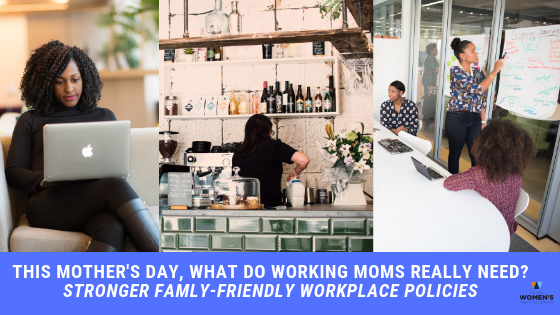What Moms Really Need: Stronger Family-Friendly Workplace Policies
Saturday, May 11th, 2019
THE PERFECT GIFT FOR MOM:
For the last few weeks, my inbox has been a constant stream of incoming emails from companies showcasing their upcoming sales on gifts for Mother’s day, from personalized mugs, to her favorite book, and even Jeni’s ice cream. All of these advertisements are boasting of the perfect gift to get mom for Mother’s Day. But there are some things all moms need that you won’t find on sale or online that far outweighs even the handcrafted card: stronger family-friendly workplace policies that help moms balance their role as caregivers and breadwinners.
WHAT MOMS REALLY NEED: STRONGER FAMILY-FRIENDLY PUBLIC POLICIES
Mothers are the backbone of families, they are increasingly likely to be the breadwinner in Ohio households, and they disproportionately take on caregiving duties for children and sick or aging family members. In many families, women are playing a dual role of caregiver and breadwinner. In fact, in Ohio, 85 percent of Black mothers, 62 percent of Latina mothers and 53 percent of white mothers are key family breadwinners. Yet, many of the public policies in Ohio workplaces do not match this reality.
Because women are often the primary family caregiver, the stakes are even higher for them when they are unable to make ends meet. Two in five female-headed families with children are living in poverty – that’s nearly 90 percent higher than that of male-headed families with children. Ohio lacks many foundational policies that would promote full economic prosperity and opportunity for women – holding back women, families, and our state as a whole.
Here are ten ways that policymakers at the Statehouse and in Congress can help support moms:
1.) Increase access to paid family and medical leave: In the absence of a national standard on paid leave, only 17 percent of American workers have access to a paid leave policy through their employer, and only 4 percent of low-wage workers have access to a policy. Black and Latina women are even less likely to have access to paid leave, which exacerbates the wealth gaps and racial disparities among families of color and white families. Paid family and medical leave policies provide workers with financial support that they need to take time off of work to care for a loved one or address their own health issue without risking their economic security. And for new moms, access to paid leave is critical to short-term and long-term health, increased and sustained workplace participation, and their family’s economic security. By having access to paid family leave, women are less likely to take a leave of absence from their jobs or exit the workforce entirely, which benefits the economy and the whole family.
2.) Strengthen the Earned Income Tax Credit: The EITC is a crucial worker support designed to reward work and strengthen families by helping hard-working parents make ends meet, particularly among women with low-incomes who are struggling to support children on their own. It’s estimated that 64 percent of households in Ohio claiming the federal EITC are households with working women. Federal legislation to strengthen the EITC would help nearly 600,000 Ohio working mothers. A strong EITC can help reduce these barriers by providing working mothers in Ohio with additional support to invest back into their family, using their refunds towards basic needs such as food, housing, health care, child care, and transportation.
3.) Increase access to affordable child care for working moms: Expanding access to affordable of child care has clear, undeniable connections to the workforce participation of working mothers and the economic stability of women and their families. According to a report released by Policy Matters Ohio, the average cost of providing child care for a one-year-old is over $14,000 per year. This astronomical cost of affording child care composes a large share of many household budgets, and the rising costs of child care are leaving far too many families without options for their children or themselves, many times pushing workers, mostly women, out of the workforce entirely to take on the caregiving duties.
4.) Enact fair scheduling laws for women in the low-wage workforce: Women make up a disproportionate share of the low-wage workforce, where unpredictable, unstable work schedules can make it difficult or impossible for working moms to make ends meet and care for their families. Often times, when workers are at the will of unpredictable schedules, without a voice in the process, they can have difficulty securing child care, pursuing educational opportunities, or receive medical care they need. Enacting fair scheduling laws, such as requiring employers to post work schedules with enough notice, help to create more stable work schedules for low-wage workers, which provides a better balance for their home and work responsibilities, promotes workforce participation, and reduces employee turnover.
5.) Increase minimum wage laws and eliminate the tipped wage: In Ohio, nearly seven in ten minimum wage workers are women, and women of color represent a disproportionate share of these workers – particularly Black women who are overrepresented in three of the nation’s lowest wage-earning, highest growth jobs. Women make up nearly three-quarters of the tipped wage workforce in Ohio; receiving less stable pay and experiencing a poverty rate that is twice as high as the rate for other workers. Raising the wages of minimum wage workers, which has remained far below the cost of living, and completely eliminating the practice of tipped wages would help support the financial security of women, who are overrepresented in the low-wage workforce, and their families.
6.) Create protections from sexual harassment and violence in the workplace: Women disproportionately experience domestic violence and sexual harassment and violence – issues that not only affect the health and safety of women, but also permeate into the workforce by affecting productivity, jeopardizing the safety of victims and co-workers, and increasing absenteeism and employee turnover. Research estimates that the average lifetime cost of intimate partner violence for women is $103,767. Women of color and immigrant women are particularly vulnerable to sexual harassment and assault in the workplace as they are overrepresented in lower-wage industries, which have stark power imbalances and meager legal protections.
7.) Ensure access to reproductive health care coverage, including abortion care and contraception: Without access to adequate, comprehensive health care and treatment, the goal of economic security is cut short before it begins – but affordable coverage and care are out of reach for many, particularly when it comes to reproductive health care services. Access to contraception and abortion care is directly linked to women’s educational attainment, workforce participation, and economic security. Women of color, and especially Black women, are disproportionately likely to be denied or unable to access resources, services, and information related to their reproductive health, which prevents them from experiencing maximum health, wellbeing, and birth outcomes. It is vital for women’s health and well-being, as well as their workforce participation and economic security, that insurance coverage they receive through their employer includes comprehensive reproductive health care services.
8.) Provide non-discrimination protections in the workplace for LGBTQ workers: In Ohio, LGBTQ women can still face discrimination in the workplace, in housing, and in public accommodations, without legal ramifications. Without non-discrimination protections for LGBTQ workers in the workplace, someone can still be legally fired for being LGBTQ. Without legal protections, transgender women, especially transgender women of color, are especially at risk.
9.) Enact equal pay laws to address unfair and discriminatory hiring and salary practices: Equal pay is crucially important to the financial security of all women and their families, but the persistent gender wage gap remains a harsh reality for women – and the gap is even larger for women of color. Unfair wage disparities not only impact women’s paychecks now, but also have long-term consequences for women’s wealth attainment, investment, and retirement savings. In Ohio, the gap is slightly larger than the national average with women typically earning just 75 cents for every dollar men make, totaling an annual wage gap of $12,686. The pay disparities are even larger for women of color working in Ohio: Black women are paid 64 cents and Latinas are paid 61 cents for every dollar paid to white, non-Hispanic men. Wage inequality means that women have less to spend on themselves and their families, invest and save for the future, and put back into businesses and the local economy.
10.) Protect the rights of workers to organize and collectively bargain: The rights of workers to collectively bargain for fair wages, benefits, and working conditions is crucial for working women who belong to a union. For example, unionized women experience a smaller wage gap than women who are not represented by a union. Overall, the gender wage gap for union members is 53 percent smaller than the wage gap for non-union workers.
This Mother’s Day, join us in our efforts to give moms the access to supportive, family-friendly workplace policies they need to thrive, provide for their families, and balance the demands of work and responsibilities of family.

Add your voice: This Mother’s Day, it is important to lift up the real policy change that is needed to better support working moms in the workplace. Help us get the word out by sharing this post on Twitter, showing policymakers what working moms really need. (Click here to Tweet)
Share your story: Right now, we are making a push in the Statehouse and Congress for a comprehensive, inclusive Paid Family Leave policy. As we work to advance paid family leave in Ohio, we will be lifting up the voices of those needing or receiving paid leave — and we need your voice in this fight. Have you ever taken paid or unpaid leave to care for a loved one or yourself, or had someone take leave to care for you? Have you ever needed to take family or medical leave, but found out this was impossible when unpaid leave was your only option? We want to hear from you – help us make a difference in the policy landscape by sharing your paid leave experience.
Commit to being an advocate at the Statehouse: Want to take your advocacy to the next level? Become an advocate for women and families in the Ohio Statehouse by committing to join our advocacy efforts, such as providing testimony if bills related to these issues receive a hearing. Fill out a ‘Be an Advocate’ form online.
